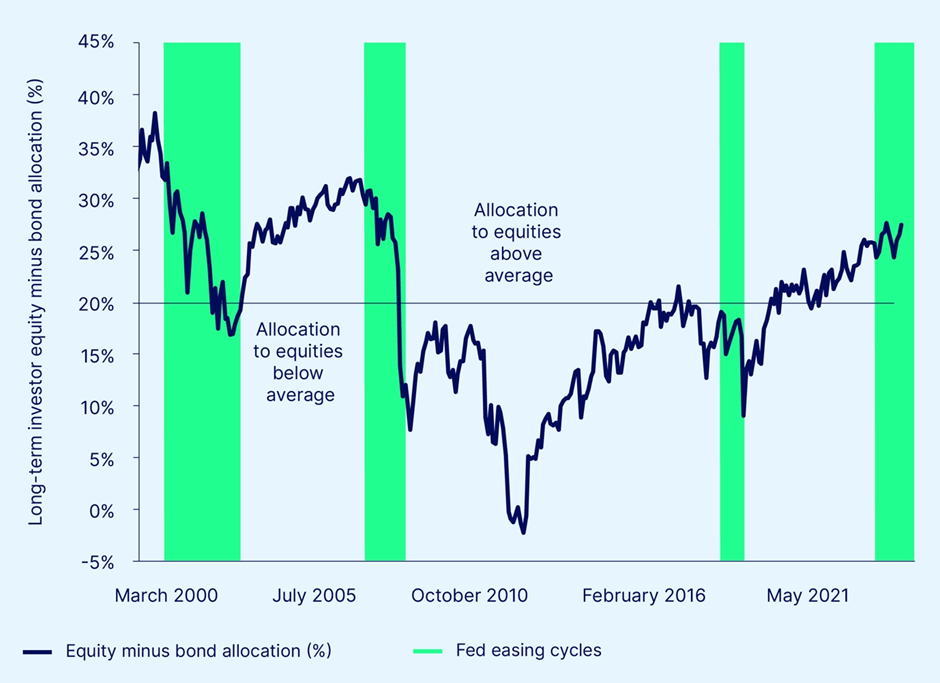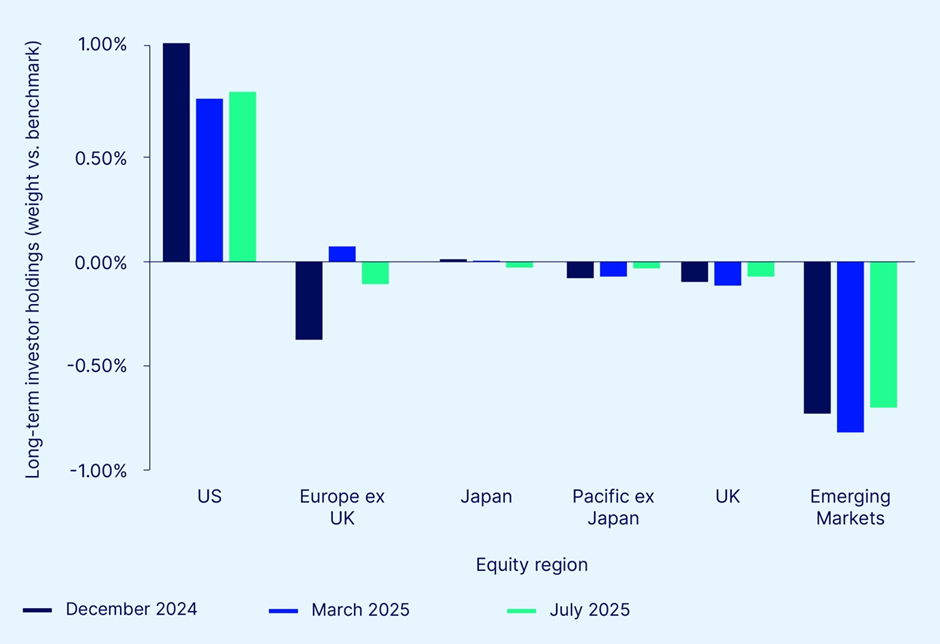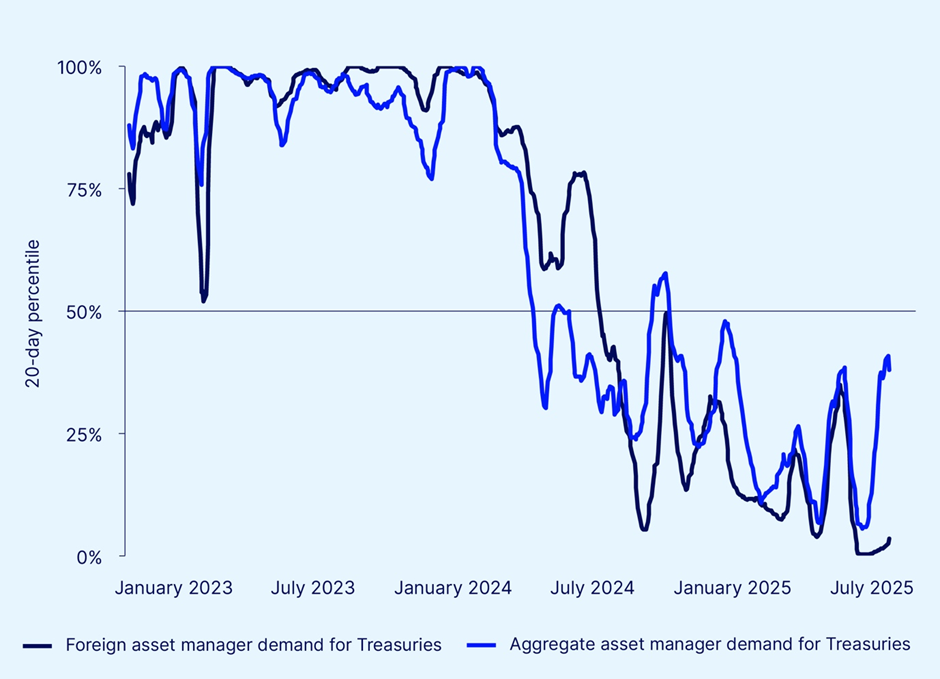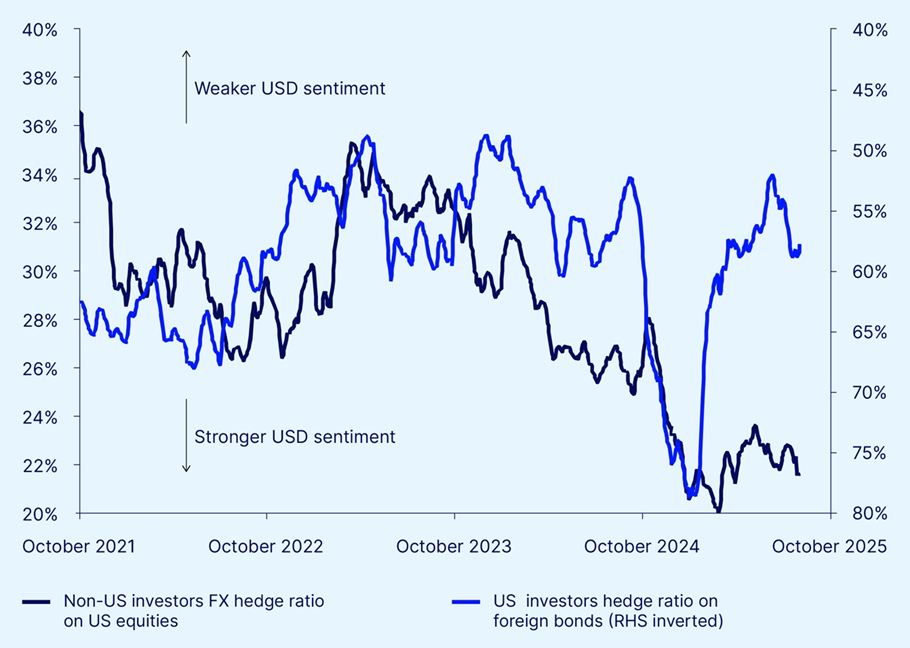August 28, 2025
What to Watch
Complimentary CONTENT
Exceptions to US exceptionalism
By: Michael Metcalfe
Summary
By Michael Metcalfe, Head of Macro Strategy
Entering 2025,
we pinpointed several critical fault lines and promising updrafts for financial
markets. The year has been a rollercoaster, and it's no surprise that both
challenges and opportunities have emerged, leaving us with an outlook that's equally
optimistic and cautious.
The key questions we posed at the start of
the year remain as relevant as ever. And just as we did in our mid-April
update, we revisit those questions here, leveraging the latest readings of State
Street’s investor behavior metrics. In the process, we explore the topic of “United
States exceptionalism.” Will it continue to dominate market consensus, or are
we on the brink of a significant rebalancing?
Investors remain overweight equities
By Michael
Metcalfe, Head of Macro Strategy
Allocations are back to peak optimism.
Investors entered 2025 with a high allocation in equities relative to bonds.
Over the past 25 years, the average allocation to equities has been around 20
percent above the allocation to fixed income, in line with a 60/40 portfolio
approach. In January, it peaked at 7.5 percent above this long-run average, reaching
a 15-year high.
While this overweight more than halved
during the turbulent three months that followed, investors never really gave up
on equities. This sentiment was reinforced by the rapid rebuild of the equity
overweight, nearly reaching its January high by the end of July. This brings us
back to the question we asked at the beginning of the year: Will the earnings
and economic outlook justify such a risk-seeking allocation to equities?
Federal Reserve easing cycles usually coincide
with a double-digit reallocation out of equities back to bonds. Once again,
this cycle is proving to be different. Optimists will point to the rapid
rebound in equity sentiment after its first quarter slip as another
demonstration of the resilience of equity fundamentals. However, this also
means that vulnerabilities to the outlook have returned. As seen in Figure 1, asset
manager allocations to equities are stretched once again to levels seen only in
the run-ups to August 2000 and July 2007, which are troubling precedents even
if this time is different.
Figure 1:
Asset manager equity versus bond allocations

Source: State Street Markets
US equities and US tech remain exceptional
The answer to the question we posed at the
start of the year, “Will the US remain exceptional?” is a definitive yes! Investors
are overweight equities as discussed above, but within equities, the only
overweight across regions is still the US.
By the end of March, investor holdings of
US stocks above benchmark weight had been reduced by around one fifth, and
there was a flirtation with above-benchmark holdings in European stocks. But
this proved brief: By July, holdings in US equities had begun to rise again
modestly.
US holdings are still lower than they were
at the beginning of the year, and so underweights in Europe, the United Kingdom
and emerging markets are also all a little smaller. So one could argue that the
US, from an equity viewpoint, is a little less exceptional than it was in
December, but only marginally so, as shown in Figure 2. The fact that US
equities remain the only region where investors are willing to retain a
significant overweight, in spite of all the geopolitical and policy
uncertainties in 2025, highlights the resilience of this view.
As State Street Markets’ head of Equity
Research, Marija Veitmane argued back in January, it is a view supported by
robust relative earnings growth, and this was once again borne out by a strong second-quarter
earnings season, especially in tech. US equity exceptionalism remains a
well-earned narrative.
Figure 2: Investors' equity allocations across regions: A little less US centric, but still US centric

Source: State Street Markets
Trouble ahead for Treasuries
While investor sentiment toward US equities
has been robust, the same cannot be said for US Treasuries. After a volatile
first four months, 10-year yields have been stuck around 4.3 percent. Despite
reduced US growth expectations, inflation expectations have risen due to
anticipated tariff impacts on consumer prices, which we can track using
PriceStats® data. The US budget bill has also locked in significant fiscal
stimulus and increased Treasury supply.
Against this mixed backdrop for Treasuries,
asset manager demand has been tepid, especially among international investors
and for longer-dated bonds. This trend isn't new; as shown in Figure 3, foreign
asset manager demand for Treasuries has been below average for a year.
Conversely, there's been a recovery in foreign demand for German and Japanese
government debt. This reinforces our earlier point: Demand for US equities is
exceptional and not mirrored by sovereign fixed-income investors.
Figure 3:
Asset manager demand for Treasuries

Source: State Street Markets
And questions remain around the US dollar
The question now is whether the US dollar
depreciation can go any further. The US dollar depreciated by almost 10 percent
in the first seven months of 2025, marking its worst start to a year in over
two decades. This move occurred despite interest rate differentials not
justifying such weakness. Our analysis points to two main factors: the rise in
policy uncertainty, which has sapped US dollar strength, and the dramatic
change in asset manager hedging activity over the past nine months.
On this latter point — and in contrast with
the behavior observed in the Treasury market — the change has been led by
US-based investors. For fixed-income managers based in the US, the fear of a
rapid US dollar appreciation following the US Presidential election manifested
itself in a surge in forward US dollar buying that took their hedge ratio on
their foreign bond holdings to a nearly
80 percent, a 25-year high.
This ratio peaked in mid-January and as the
feared US dollar overshoot failed to materialize, US managers sold their US
dollars forward rapidly to bring their hedge ratio back down below 60 percent,
where it has finally consolidated in July, close to its long-run average. This
part of the sentiment change would seem therefore to be done. Indeed, in July
we even saw some signs of recovery in domestic demand for the dollar.
However, not all investors have adjusted to
the US dollar’s weaker trend. Non-US investor hedge ratios on their US equity
holdings remain unusually low. This means that for all the exceptional foreign
buying of US equities in the past five years, there have been relatively fewer forward
sales of the US dollar to offset the currency risk.
This is largely understandable, as typically during
this period, the US dollar has offered a natural hedge to equities. Generally
when equities have declined, the US dollar has appreciated given its empirical
safe-haven status. But
this relationship has been challenged so far in 2025. The US dollar has depreciated alongside equity market
declines. This may alter the view that non-US investors should maintain such a
low hedge ratio on their US equity exposures, and is one area we are watching
closely in the second half of the year for a potential continuation of forward
US dollar sales from asset managers. So in contrast to US equities, it has been
the weakness of the US dollar — driven by the change in investor attitude
toward it — that has been exceptional
(see Figure 4).
Figure 4: Changing attitudes to the US dollar

Source: State Street Markets
Exceptions to US exceptionalism for the remainder of 2025 and beyond
After a highly uncertain eight months, US
equity dominance — particularly in tech — remains largely unchallenged.
Investor sentiment and fundamental metrics both support this view. US
exceptionalism is alive and well, but it's increasingly concentrated in US
equities. Alternatives in other regions or asset classes still lack the
fundamentals to mount a serious challenge.
The view through other asset classes is
much less sanguine. The lack of foreign demand for long-dated Treasuries
remains troubling, and investor hedging of the US dollar has shifted abruptly against
the currency for much of this year, even though interest rate differentials
have remained in its favor. Both behaviors point to a more cautious outlook as
the impact of economic and policy uncertainties in the US and elsewhere
continue to unfold.
Looking ahead to the remainder of 2025 —
with the US budget set, trade policy beginning to crystallize and the interest
rate path potentially clearing — policy uncertainty may start to decline. Media
focus on this topic has already begun to edge lower over the summer. This in
turn may help to alleviate investor concerns about Treasuries and the US
dollar. Domestic investor demand for both is already showing signs of recovery.
But it remains early days. The true
economic impact of policy changes will take some time to play out fully, even
in real-time data such as PriceStats. Against this backdrop, such high investor
allocations to equities implies a significant vulnerability to much weaker
economic news if it eventually comes.
Finally, if uncertainty does indeed subside in the
remainder of 2025, we will then begin to get answers to fundamental questions: Were
reassessments of the US dollar and Treasuries tactical blips in contrast with
the resilience of equity holdings? Or were they the beginning of a more
structural shift out of these US assets?
Disclaimer & Risk
Author Bios

Michael Metcalfe
Michael is Senior Managing Director and Head of Macro Strategy at State Street Markets
The information provided herein is not intended to suggest or recommend any investment or investment strategy, does not constitute investment advice, does not constitute investment research and is not a solicitation to buy or sell securities. It does not take into account any investor's particular investment objectives, strategies or tax status. Past performance is no guarantee of future results. For more information, please see the link for the marketing disclaimer for State Street Markets research, available in the “Legal Disclosure” section of our “Disclosures” page referenced in the footer below.